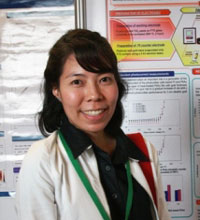March 13, 2012
 |
| Dr. Gamolwan Tumcharern |
Researchers at the National Nanotechnology Center (NANOTEC), Chulalongkorn University, and Stanford University have successfully synthesis titania nanoparticles and carbon nanotubes (CNT) using hydrothermal process to provide the highest photoconversion efficiency.
“Dye sensitized solar cell (DSSC) has gained much research interest in recent years for its positive characteristics in contributing to renewable energy generator” said Dr. Gamolwan Tumcharern a researcher at NanoSens Lab at NANOTEC. “The ability to synthesize hybridized material of titanate nanoparticles and CNT using hydrothermal process has greatly increased the photoconversion efficiency of DSSC”.
Because DSSC could potentially be made of low-cost materials, and does not require elaborate apparatus to manufacture, this cell is technically attractive as a renewable energy generator. Likewise, manufacturing DSSC can be significantly less expensive than older solid-state cell designs. It can also be engineered into flexible sheets and is mechanically robust, requiring no protection from minor events like hail or tree strikes. For this reason, the ability to increase the efficiency of photoconversion is of most interest to the energy sector.
The researchers reported their work in a paper published by Materials Research Bulletin.
Collaborators on this research included the Faculty of Engineering at Chulalongkorn University, Thailand, Department of Energy Resource Engineering at Stanford University, USA, and NanoSens Lab at National Nanotechnology Center, Thailand.
Source: National Nanotechnology Center (NANOTEC)
Additional Information:
0 comments:
Post a Comment